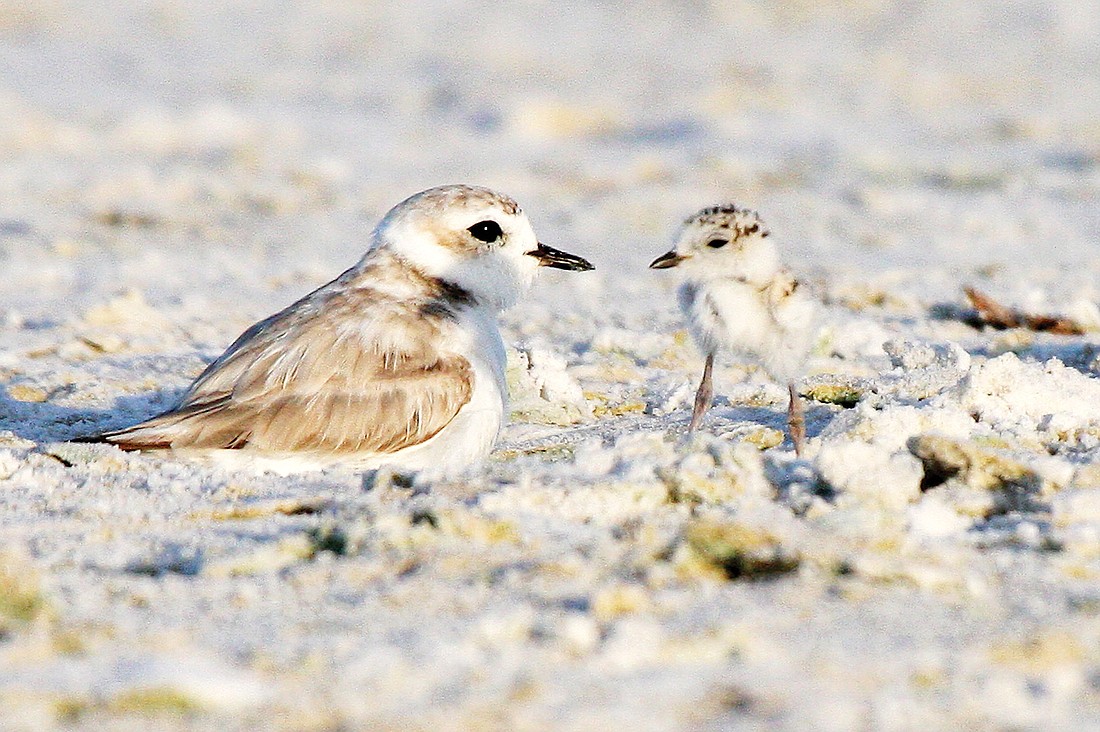- April 19, 2024
-
-
Loading

Loading

It appeared Tropical Storm Debby wiped out hope for any new snowy plover chicks after it destroyed what some thought to be the last nest in June.
But, two nests have appeared since. Facing threats from four-legged natural predators and two-legged interlopers, two hatchlings have survived nearly a week after hatching — and another is poised to break out of its shell, according to Siesta Key Association President Catherine Luckner.
Volunteers from the Sarasota Audubon Society and SKA have roped off nesting areas and placed warning signs in strategic locations to prevent startled plover mothers from abandoning nests. During a SKA meeting Aug. 2, Sarasota County Parks and Recreation Manager George Tatge explained how humans or their dogs, trudging through dune vegetation, can scare the shorebird matriarchs and leave eggs vulnerable to raccoon predation.
“The chicks have been roving great distances between the public beach and the Access 9 area,” Luckner said in an email message.
The tiny sandy-shaded hatchlings are difficult to discern among the shoreline sands, which they traverse to reach clumps of red algae to scavenge for food.
The devastating tropical storm may have muted the shorebirds’ numbers, but it brought more than 200 tons of seaweed to Sarasota County beaches, according to a county news release.
According to volunteer reports, the mother shields the chicks in the algae — or wrack, which has served as temporary shelter. “The (hen) figured out people don’t want to step in the wrack,” Luckner said.
But, shorebirds are overlooked in terms of regulatory protection, Tatge said at the meeting. It is illegal to physically disturb nests and take plover eggs, but the boundary created by ropes and stakes in the dunes near Siesta beach access 8 is merely “symbolic fencing,” according to the Florida Shorebird Alliance.
And the signs posted by Luckner and others are informational, meaning there’s not much legal firepower to stop people from walking close to nests. FSA suggests the safest distance from a snowy plover settlement is nine yards, and could be as far as 50 yards, according to some avian research.
Nonetheless, Luckner said Sarasota Audubon Society President Jeanne Dubi spotted the two plover chicks Aug. 7, near the roped-off buffer zone. And 22 of the shorebirds have been sighted feeding in the wrack.
Luckner estimates the plover chicks won’t be able to fly for more than two weeks. “They are at risk and have only one parent for defense,” she said.
Click here to view FSA Posting Guidelines
Looking for bird buddies
The two baby snow plovers on Siesta Key beach have been wandering into shore regions with heavy pedestrian traffic. The Sarasota Audubon Society and the Siesta Key Association is seeking more help to steer the infant shorebirds into the safe grasp of dune vegetation or heavy seaweed deposits.
For information how you can help, contact SKA President Catherine Luckner by email at [email protected].